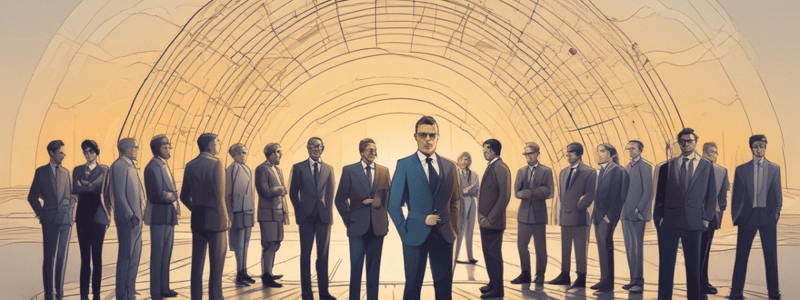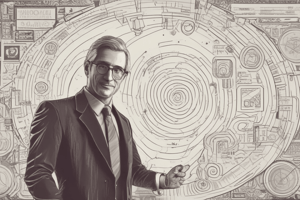Podcast
Questions and Answers
What is the primary focus of management as defined in the content?
What is the primary focus of management as defined in the content?
- Identifying and developing future leaders
- Inspiring employees to achieve personal goals
- Planning and organizing resources to achieve specific goals (correct)
- Unifying team efforts through collaborative practices
Which function of management involves matching goals to organizational objectives?
Which function of management involves matching goals to organizational objectives?
- Staffing
- Organizing
- Planning (correct)
- Leading
According to Henri Fayol's management functions, which step follows the decision-making about how to implement a plan?
According to Henri Fayol's management functions, which step follows the decision-making about how to implement a plan?
- Staffing
- Planning
- Organizing (correct)
- Leading
Which aspect is NOT typically part of the staffing function in management?
Which aspect is NOT typically part of the staffing function in management?
What critical skill must managers possess, even if they are not born leaders?
What critical skill must managers possess, even if they are not born leaders?
What statement differentiates managers from leaders according to Warren Bennis?
What statement differentiates managers from leaders according to Warren Bennis?
What is involved in the leading function of management as described?
What is involved in the leading function of management as described?
Which of the following best describes environmental scanning in staffing?
Which of the following best describes environmental scanning in staffing?
Which of the following statements accurately reflects the aim of AI-assisted job tools in hiring?
Which of the following statements accurately reflects the aim of AI-assisted job tools in hiring?
What is a key element of controlling as a management function?
What is a key element of controlling as a management function?
What is the primary focus of Classical Management Theory?
What is the primary focus of Classical Management Theory?
Which management theorist is known as the 'father of scientific management'?
Which management theorist is known as the 'father of scientific management'?
What principle is most associated with Max Weber's Bureaucratic Management Theory?
What principle is most associated with Max Weber's Bureaucratic Management Theory?
Which concept did Mary Parker Follett emphasize in her management philosophy?
Which concept did Mary Parker Follett emphasize in her management philosophy?
Which management approach is characterized by a focus on an individual's psychological aspects within the organization?
Which management approach is characterized by a focus on an individual's psychological aspects within the organization?
What was one significant contribution of Frank and Lillian Gilbreth to management theory?
What was one significant contribution of Frank and Lillian Gilbreth to management theory?
Which of the following is NOT one of Fayol's 14 principles of management?
Which of the following is NOT one of Fayol's 14 principles of management?
Which management theory primarily addresses the need for efficiency through structured work tasks?
Which management theory primarily addresses the need for efficiency through structured work tasks?
Which explanation best describes the purpose of the Human Relations Theory as established by Mayo?
Which explanation best describes the purpose of the Human Relations Theory as established by Mayo?
What does Theory X propose about employees?
What does Theory X propose about employees?
Which statement is true regarding Maslow's Hierarchy of Needs?
Which statement is true regarding Maslow's Hierarchy of Needs?
What is a key component of the Two-factor Motivation Theory formulated by Herzberg?
What is a key component of the Two-factor Motivation Theory formulated by Herzberg?
In the context of modern management theory, what aspect is emphasized in addition to scientific methodology?
In the context of modern management theory, what aspect is emphasized in addition to scientific methodology?
What does Systems Theory of Management propose about organizations?
What does Systems Theory of Management propose about organizations?
Which principle is central to Statistical Quality Control as proposed by Shewhart?
Which principle is central to Statistical Quality Control as proposed by Shewhart?
Which theory emphasizes that not all employees need to be motivated in the same way?
Which theory emphasizes that not all employees need to be motivated in the same way?
What is a characteristic of the modern approach to management?
What is a characteristic of the modern approach to management?
According to Herzberg's theory, which of the following factors is most likely to cause job satisfaction?
According to Herzberg's theory, which of the following factors is most likely to cause job satisfaction?
What was the primary focus of lean thinking introduced in the 1990s?
What was the primary focus of lean thinking introduced in the 1990s?
What does the DMAIC cycle in Six Sigma stand for?
What does the DMAIC cycle in Six Sigma stand for?
In 21st-century management, what has shifted to be more important than merely making a profit?
In 21st-century management, what has shifted to be more important than merely making a profit?
What has been a significant change in organizational structures post-Coronavirus pandemic?
What has been a significant change in organizational structures post-Coronavirus pandemic?
What key operational shift was influenced by the pandemic regarding employee work conditions?
What key operational shift was influenced by the pandemic regarding employee work conditions?
Which of the following statements best captures a key principle of management theories in the 21st century?
Which of the following statements best captures a key principle of management theories in the 21st century?
What is a significant consequence of digitalization in post-pandemic organizations?
What is a significant consequence of digitalization in post-pandemic organizations?
Which of the following is a fundamental principle attributed to Lean Six Sigma?
Which of the following is a fundamental principle attributed to Lean Six Sigma?
How has employee demand shifted in terms of organizational practices as a result of the pandemic?
How has employee demand shifted in terms of organizational practices as a result of the pandemic?
What management theory emphasizes the need for organizations to adapt to their environments?
What management theory emphasizes the need for organizations to adapt to their environments?
What was a primary focus of Total Quality Management (TQM)?
What was a primary focus of Total Quality Management (TQM)?
Which principle is part of Juran's Trilogy for achieving quality?
Which principle is part of Juran's Trilogy for achieving quality?
In Contingency Management Theory, what is emphasized as key to effective management?
In Contingency Management Theory, what is emphasized as key to effective management?
Which is NOT a characteristic of Theory Z management?
Which is NOT a characteristic of Theory Z management?
What is the primary purpose of the DMAIC process in Six Sigma?
What is the primary purpose of the DMAIC process in Six Sigma?
Who is credited with introducing the concept of Lean Thinking?
Who is credited with introducing the concept of Lean Thinking?
What does the Pareto principle in Juran's management approach suggest?
What does the Pareto principle in Juran's management approach suggest?
Which of the following statements best describes Management by Objectives (MBO)?
Which of the following statements best describes Management by Objectives (MBO)?
Which quality improvement methodology was created to counteract variations in manufacturing processes?
Which quality improvement methodology was created to counteract variations in manufacturing processes?
What is the outcome associated with U.S. companies adopting Theory Z?
What is the outcome associated with U.S. companies adopting Theory Z?
What is the primary aim of change management?
What is the primary aim of change management?
Which of the following stages is NOT part of the PDCA Cycle?
Which of the following stages is NOT part of the PDCA Cycle?
Which statement best describes the Kübler-Ross Change Curve as applied to organizations?
Which statement best describes the Kübler-Ross Change Curve as applied to organizations?
Which of the following elements should be included in a structured approach to employee wellness?
Which of the following elements should be included in a structured approach to employee wellness?
What is a common limitation of focusing solely on the process in change management?
What is a common limitation of focusing solely on the process in change management?
In the PDCA Cycle, what occurs during the 'Check' phase?
In the PDCA Cycle, what occurs during the 'Check' phase?
Which type of change does change management NOT typically address?
Which type of change does change management NOT typically address?
Why must managers adapt to workplace culture changes post-pandemic?
Why must managers adapt to workplace culture changes post-pandemic?
What primary aspect does the focus on people in change management emphasize?
What primary aspect does the focus on people in change management emphasize?
Flashcards are hidden until you start studying
Study Notes
Introduction to Management and Leadership
- Distinction between leaders and managers: Leaders do the right thing; managers do things right (Warren Bennis).
- Successful organizations require a balance of both leadership and management skills.
Functions of Management by Henri Fayol
- Planning: Setting organizational goals and identifying strategies accordingly.
- Organizing: Structuring the organization and allocating resources effectively.
- Leading: Articulating a vision and influencing employees towards goals.
- Staffing: Continuous recruitment, selection, onboarding, and retention of employees.
- Controlling: Monitoring progress and implementing corrective actions to achieve goals.
Management Theories and Theorists
-
Classical Management Theory: Emphasizes productivity and a hierarchical structure with centralized authority.
- Scientific Management (Frederick W. Taylor): Focuses on efficiency using observation and analysis.
- Bureaucratic Theory (Max Weber): Clear hierarchy and rules controlling organizational behavior.
- Administrative Management (Henri Fayol): Focus on organizational structure and processes.
-
Behavioral Management Theory: Understanding individual motivation and social dynamics.
- Human Relations Theory (George Elton Mayo): Job satisfaction linked to employee participation.
- Theory X and Theory Y (Douglas McGregor): Differentiates between oversight and intrinsic motivation.
- Hierarchy of Needs (Abraham Maslow): Human motivation based on a hierarchy from basic needs to self-actualization.
- Two-factor Motivation Theory (Frederick Herzberg): Distinction between job satisfaction and dissatisfaction factors.
-
Modern Management Theory: Integrates scientific and humanistic approaches, promoting adaptability.
- Systems Theory: Organizations as interrelated systems.
- Total Quality Management (TQM): Continuous improvement focused on quality and customer satisfaction.
- Contingency Management Theory (Fred Fiedler): Management effectiveness depends on situational factors.
Quality Improvement Methodologies
- Six Sigma: Management system reducing process variability; employs DMAIC for existing processes and DMADV for new processes.
- Lean Thinking: Focus on maximizing value while minimizing waste, attributed to Toyota's production system.
- Lean Six Sigma: Combining lean principles with Six Sigma to enhance efficiency and quality.
21st Century Management Dynamics
- Shift in business focus: From profit-making to value creation and customer satisfaction.
- Workers' expectations have evolved to include flexible schedules and job satisfaction amidst changing work environments.
- The impact of the Coronavirus pandemic necessitated agility and flexibility in workplace management strategies.
Management in a Post-Pandemic Era
- Organizations adapted to remote work, leveraging technology for operational continuity.
- Increased reliance on contractors and part-time employees, with an emphasis on employee wellness.
- Managers need new skills to deal with hybrid teams, adapt business continuity plans, and foster a positive workplace culture.
Change Management
- Defined as a structured approach to transition an organization from current to future states.
- Change can be strategic, structural, technological, or unplanned.
- Two approaches: Process-focused and people-focused.
- PDCA Cycle (Deming Wheel): Model for continuous improvement consisting of four stages: Plan, Do, Check, Act.### Impact of the Pandemic on Work Culture
- The pandemic accelerated trends such as digitalization, remote work, and shifting workforce dynamics towards more contractors.
- Employee wellness has gained increased importance, necessitating cultural acceptance of change within organizations.
Change Management and Employee Attitudes
- A cultural shift requires changes in attitudes from employees at all levels, from entry-level positions to top management.
- The Kübler-Ross Change Curve, created by Elisabeth Kübler-Ross in 1969, outlines five stages of grief, which have been adapted for organizational change.
Kübler-Ross Change Curve Model
- The Change Curve helps organizations understand emotional responses to significant changes, including transitioning back to full-time work post-pandemic.
- Employees' reluctance to fully return to the office can be analyzed through this model, highlighting job-seeking tendencies.
Individual Experience with Change
- Individuals are responsible for identifying their feelings regarding change and determining personal management strategies for it.
- A four-quadrant worksheet can assist in self-assessment:
- Current feelings about change
- Personal management strategies for coping
- Identifying colleagues' needs during change
- Ways to offer support to peers
Managerial Support During Change
- Managers can facilitate employee transitions by:
- Clearly communicating the details of the change and addressing questions.
- Anticipating negative reactions and preparing to handle them empathetically.
- Providing necessary training and resources to ease the adjustment process.
- Regularly checking in with employees to gauge their feelings and comfort levels with the change.
- Evaluating the change process's outcomes to improve future change initiatives.
Studying That Suits You
Use AI to generate personalized quizzes and flashcards to suit your learning preferences.




